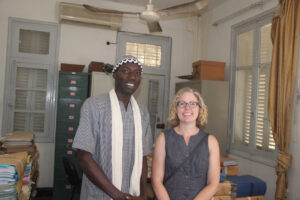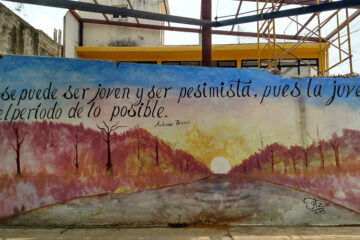by Beth Buggenhagen, Indiana University
In May 2022 artists, curators, and scholars convened in Senegal’s capital city, Dakar for Dak’Art, the Biennial of Contemporary African Art. Postponed in 2020 due to COVID, its then theme, I Ndaffa, or Into the Fire, was more relevant than ever. It reflected the conditions and constraints of living through an age marked by pandemic.
In Spring 2020 I was on my way to Dak’Art in Senegal’s capital for sabbatical research for my book The Future is in Your Hands, Portrait Photography from Senegal (IU Press, forthcoming). The largest biennial of contemporary art on the continent and a major biennial in the global south, this iteration was to be spectacular and thus not to be missed. Not only was this the biennial’s twentieth anniversary, but the event also coincided with the opening of two new museums: a museum of contemporary art in Dakar, the Museum of Black Civilizations, and the opening of a new museum of photography in the riverine city of Saint-Louis, the Museum of Photography (MuPHO). Dak’Art 2020 would have taken place just after the Sarr Savoy report from academics and researchers Bénédicte Savoy and Felwine Sarr to implement the return of thousands of artworks was due to come out in November 2018.
The foreclosure of these events and openings for many occurred when Senegal shut down the airport, terminated international flights, and closed the borders to prevent the spread of COVID in early spring. A series of cancellations began to unfold for artists, scholars, and curators worldwide. In these new and emergent conditions, the ever evolving now of fieldwork began to look strange and unknowable. Like many scholars and artists, I also refashioned my plans to adapt to new constraints, constraints that at the time, no one knew would carry on for several years and come to define an era.
Unable to engage in field-based research with artists, curators, and archivists, and unable to enter archives and work with museum and family collections how did I rethink my research methods and materials? If the mantra of ethnographic fieldwork is long term intensive research and up close through participant observation, then the mantra of museum anthropology is looking closely at objects in collaboration with communities from which they originate. Dak’Art had served as a platform for these convergences and conversations. How did I use this time, fraught as it was with added family responsibilities in the context of so much sickness in the community? Like many scholars, I turned to the emergent forms of digital connection like participating in zooms offering new proximity to artists who themselves also could not travel to show their work and take up residencies. Participation in these new platforms for interaction led me to think more broadly about the role of the digital in research, as a method, as a resource, and as data and materials. I questioned how I had approached the material culture of photography predicated on an opposition between the material and the digital. Photographs were tactile, tangible forms of material culture passed from hand to hand with loving creases from being tucked in pockets and fingerprints scattershot across their surface. What connection if any, could these heirloom objects have to pristine digitized images produced through digitization projects underway in museums but off from the social life that gave them meaning and value? These new lines of thinking in finding connections between the material and the digital led me to reflect on and ultimately, to reposition the argument of my book so that I could complete the manuscript absent travel and field and museum based research with my interlocutors.
In museum anthropology scholars engage in a method best described as close looking at objects in collections. Prolonged careful study of materials generates data often accompanied by interviewing with these objects in the broader community in which the objects originated. This participatory and collaborative method situates objects in space and time and creates meaningful connections between collections and communities. For several years prior to the pandemic, I had been engaged in field based research in Senegal as well as collections research at the Smithsonian National Museum of African Art in Washington, DC. Much of my fieldwork for my book unfolded in homes, at family ceremonies, in the studios and streets with photographers, at exhibitions, and in collections. One such methodology, referred to as photo-elicitation, is an older anthropological approach taken by John Collier that involves asking with pictures (1967, 48). In this method, the anthropologist shows images to interlocutors, asking them to describe what they se as well as posing specific questions about the photos. Yet, rather than treating the research process as one in which the anthropologist elicits information from the key informant, a process that Elizabeth Edwards has called “forensic” (2011, 181), ethnography can also explore how photographs, new and old, “assume their own dynamics of sociability within communities” (ibid). In Senegal, I had engaged in both close looking at photographys and photo elicitation in the national archives with the photographer Ibrahima Thiam. I had planned to continue along these lines in personal, private, and museum collections throughout Senegal in 2020.

Beth Buggenhagen and Ibrahima Thiam in the National Archives
Before COVID, as Jennifer Hart put it so well “I was going to write a different book.” My last book, Muslim Families in Global Senegal (IU Press, 2012) traced the objects of value women put in motion that were both the reason and the outcome of the global networks of Senegalese Murids. These were objects like locally woven textiles, an important form of women’s wealth and value, religious texts and objects, and photographs. Things that filled homes with importance and meaning for a community caught between worlds—the worlds of migrants and the worlds of those who remained at home. These objects wove these worlds together creating intersections and concretizing otherwise ephemeral relations.
In this light, photographs were moving and movable objects, ever more so in their digitized forms. Personal portraits showed that a person was well cared for by family, friends, and community who often contributed to the finery in which a person might be photographed. Portraits worked to extend person’s reputation and integrate them into circuits of wealth and value that sustained social, political, and economic life. I had been exploring these issues related to photography further through a series of research trips to Senegal and hosting artists for residencies at Indiana University including George Osodi, Omar Victor Diop, and Ibrahima Thiam over the past decade since my last book was published.
In 2020 I planned to continue that research in Senegal through several different modalities, participant observation at Dak’Art, interviewing with collections in Saint-Louis, archival research, and interviews. Yet instead, I found myself grounded in Bloomington, Indiana by late March 2020. Reflecting on how to forge ahead with a book manuscript already well underway, I turned to the visual. I contemplated some of the images in Ibrahima Thiam’s series, “Portraits ‘Vintage,’” begun in 2017, that he had shared with me during his visit to Indiana University in early 2019. I remembered when I had first met him in Dakar in 2016 and our long conversations about portraiture, collections, and collecting. I remembered our conversations about his efforts to protect this national patrimony.
In “Portraits ‘Vintage’” Thiam invites his sitters to select a vintage print from his personal collection and to hold it up in one hand in front of their face for a portrait. I pondered whether the digital would afford new ways of looking at the material, the vintage portraits held ever so gingerly in his sitter’s hands. Thiam had been asking himself similar questions about links between the digital and the material rather than seeing their opposition. In his body of work, Portraits “Vintage,” Thiam works with archival photographs reproducing them in digital form. His sitters hold the portraits in their hands pointing to and constituting the material links with the digital.
In a similar vein, if one had to do museum anthropology without the conversations with community members while viewing a museums collections and by looking at digitized images of objects, could one still look closely at objects, and would doing so open a door to another way to look at the same project? Could I see my project in a new way in the same way that Thiam’s sitters saw themselves in a new way by looking at digital images? These are the sorts of questions I was confronted with as I researched digitized images of Senegalese portraiture held in museum collections worldwide during pandemic closures and travel bans.
In the period since the Sarr Savoy report on the restitution of cultural objects in 2018 museum anthropology was also evolving to placing greater emphasis on contextualizing museum collections, negotiating returning objects to communities of origin, and prioritizing digitization projects to facilitate access to holdings. Could I do museum ethnography these newly accessible digitized collections of photographs from Senegal? The danger of the digital is that visual ethnography, according to Sarah Pink, is not of communities, rather it is undertaken with communities (Sarah Pink, 2007, Doing Visual Ethnography: Images, Media and Representation in Research). Ethnography emerges from spending time with scholars, artists, and community members, building rapport as Jack Rechsteiner and Betsy Sneller, suggest. It relies on the social and the material, relationships the digital interrupts.
I had approached the digital as an impoverished form of sociality. Yet, forced to rummage through digitized collections of portraiture from Senegal in museums worldwide, I realized my curiosity grew about how the digital arose from the material and how might it be yet one more stage in contending with the material form, a question posed by museum anthropologist Haidy Geismar? In this context, it was only through museum digitization projects that their very existence outside of Senegal became known to me, and likely others. Their digitization enabled me to see not only the images themselves, but to further question how became part of museum collections in the first place. Through this line of questioning new research paths emerged for me on the worldwide movement of photographs from Senegal, movements that began when cameras first arrived on the coast of Senegal in the late 1800s and spawned a vast industry of family portraiture, colonial documentation, and postcard production.
Other new questions emerged for me such as how would contemporary photographers like Thiam regard such digitization projects? Certainly the digitization projects made the museum holdings visible, but they did not return the photographs to the social contexts that gave them life. To return to Jennifer Hart’s point about books not ending where they began, the digital, I suggest, enables us to “look at an old source in new ways”. Although I could not continue my field based work combing through archival collections throughout Senegal with Ibrahima Thiam, I could engage in questions that he and many others were posing about heritage objects like photographs. This line of inquiry turned me onto other questions emerging from this moment concerning reparations, repatriation, and restitution of museum objects to their source communities. Not only did attention to the digital help me understand how photographs circulated in and out of Senegal over the century, and help me re-frame and rewrite the first chapter and epilogue to my book, it also helped spark new questions about these heritage objects that will undoubtedly lead to new research in the future. For anyone contemplating ethnographic research perhaps moving away from the opposition between the digital and the material, the online and the in person, toward seeing connections might yield new methods as well as new insights into old problems.
